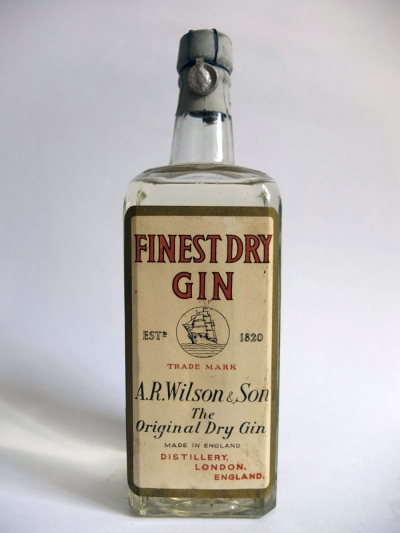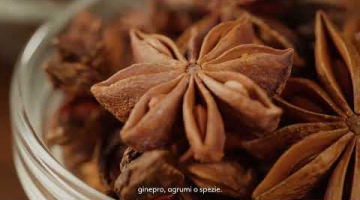Raiding the liquor cabinet is a minefield for young adults of a certain age. The shiny bottle of sambuca looks promising next to triple sec, and the layer of dust on the bottles in the back seems to indicate “steer clear.”
But the dusty bottle may have been the best choice. Despite a recent warning from Bacardi that booze goes bad, old liquors are increasingly being appreciated for their distinct flavor profiles.
Everyone knows that a grand old Bordeaux is an expensive thing of beauty—old fine wines continue to mature and develop nuanced flavor as they age in the bottle, and a global industry helps determine their quality and worth. But the merits of an old bottle of liquor aren’t as clear.
dustyhunting_ARWilson
1947-49, A. R. Wilson & Son London Dry Gin. Photos courtesy of Edgar Harden.
To be sure, the amount of time a spirit spends aging in a barrel affects its taste as the barrel imparts flavor and color onto the liquor. That’s why people wax poetic about and shell out so much for super aged whiskeys like a Macallan 25 or 23-year Pappy Van Winkle. Once those liquors are out of the barrel and inside the bottle, the liquor should, in theory, be the same whether you drink it today or 30 years from now as long as it remains unopened. But some are finding that bottles capped long ago hold a special allure, both for their taste profiles and their historical significance.
Edgar Harden first noticed something special about old spirits when he was clearing out a wine cellar for an estate sale. A former furniture specialist at Christie’s whose department was situated next to the wine department, Harden eventually set out on his own to deal in furniture and wine. After rummaging through the cellar, the owners told him to sell the Mouton but toss the case of 1960s Gordon’s gin. “I took it home, tried it, and said ‘Wow, this is good,’” Harden tells me. “It was so smooth, deep, and really interesting.”
Harden now runs the London-based Old Spirits Company, selling bottles from decades gone by to enthusiasts and the occasional bar or restaurant. He finds that older spirits are, generally speaking, mellower than their modern day counterparts, and more palpably smooth.
Other times, a vintage spirit can taste completely different. Some go bad, others take surprising turns. Gin, for example, contains juniper and a variety of different botanicals, which are apt to change over time. “In aging, because all of the distillates are plant-based materials, the composition changes as these plant-based ingredients break down, age and recombine at different rates,” Harden says.
dustyhunting_Lilet
1964, Kina Lillet.
For that reason, Harden finds liqueurs made from herbs, fruit, or things like coffee or chocolate to be among the most intriguing aged spirits. Chartreuse, which is famously made from 130 herbs, plants, and flowers, is well-positioned to develop nuanced flavor over time. Pouring Ribbons in Manhattan is renowned for its collection of Chartreuse dating back to the 1940s, and the differences between its vintages can be striking.
“Say we have two different bottles of yellow Chartreuse,” says Joaquín Simó, a partner at Pouring Ribbons who was recognized as the American bartender of the year at the 2012 edition of Tales of the Cocktail. “One might be very mild and honeyed and have a lot of fresh green notes, and maybe the other that’s a little bit older could be much more bitter with more herbaceousness, more cocoa. Some flavors can be a bit more ephemeral than others.”
There’s also a different kind of “vintage” in play. “Because there are so many natural ingredients, every year is going to be a little different,” Simó says. “We’ve opened up bottles where it smells like we walked into an Indian spice shop.”
dustyhunting_Dunbars
1930s, Dunbar’s London Sloe Gin.
Light, temperature fluctuations, and humidity—as well as less obvious factors such as how a bottle is handled—affect age and taste. Too much exposure to direct sunlight can ruin a bottle that would have been great if kept in a cellar. Harden tends to steer clear of bottles stored near train tracks, as the vibrations can throw off taste.
Vintage spirits offer exciting possibilities for cocktails. With them, those who worship the classic Savoy Cocktail Book can make a drink that more closely resemble how it was served in the 30s. You can order vintage classics at the Experimental Cocktail Club in New York or the Ritz in London, to name a couple.
At the NoMad in New York City, bar director Leo Robitschek mixes up drinks using old booze for the bar’s reserve list. He uses a 1960s Campari in a Jungle Bird—back then, Campari still got its red color from crushed cochineal beetles—and a 50-year-old cognac in the bar’s Vieux Carré that, at around $200, tops the reserve list in terms of price. It’s still a bargain compared to the £350 El Presidente made from 1910 Bacardi, 60s Grand Marnier, and 50s Carpano Antica at the London Ritz.
Robitschek compares using vintage liquor in cocktails to caviar. “Caviar is amazing on its own,” he says, noting many would argue that’s the way it should be enjoyed. “But there are also some dishes that are amazing when finished with caviar.”
dustyhunting_BolsBallerina
1960s, Bols Ballerina.
Many liquors are interesting because their manufacturing processes have changed over time or the brand has disappeared altogether. In some cases, there’s an argument that they just don’t make ‘em like they used to, what with today’s computerized distilling operations and GMO corn.
No one follows the history of the distilling industry more obsessively than American whiskey fanatics. They can recount mergers and acquisitions within the industry, changes in the distilling process, and the succession of master distillers the way a Vatican historian might detail the succession of popes. Many brands that weren’t considered high-end when they were bottled are valued today—bottles from now defunct producers like National Distillers and Stitzel-Weller. Until a couple years ago when they ran out of the stuff, if you were drinking Pappy van Winkle, it was made from Stitzel-Weller juice.
Greg Gilbert runs the blog Bourbon Dork, and in 2009 he wrote a series about “dusty hunting”—searching liquor stores, primarily in rough neighborhoods, for old bottles of whiskey forgotten on bottom shelves or in storerooms.
Gilbert has a checklist to help him properly establish a bottle’s provenance. First he looks for a tax strip, which were put on bottles before tamper-resistant caps became the norm in the 90s. If a bottle has no UPC code, Gilbert knows that the bottle is from around 1980 or before; and if it does have one, he can track where came from. A bottle with a government health warning means it came from the late 80s at the earliest. Prior to 1979, bottles were measured in English standard measurements.
dustyhunting_CanadianClub
1930s, Canadian Club.
In his heyday, Gilbert could hit about 30 liquor stores a day. “There was a time I could go into DC, walk into a liquor store, and within ten minutes I could have a dozen bottles I’d want on the counter,” he says.
Gilbert’s hauls include bottles of 60s Old Overholt, 70s Old Forrester, 80s Wild Turkey, and many more. “This is a broad statement, but in many ways whiskey made back then has more of a coating effect on the palate, and a way it carries through to the finish,” he said. Today’s whiskeys generally have more of a cleansing effect. His favorite find was an Old Fitzgerald Bottled in Bond that entered the barrel in 1965 and went into the bottle in 1971. He bought it for $11.95, and estimates it’s worth over $1,000.
Gilbert has largely given up on hunting these days. He and others have mostly bought everything worth drinking.
Gilbert is quick to point out that, for him, hunting dusties isn’t about money, though it is for some. The primary reason he searches out old bottles is to enjoy some good whiskey and drink a bit of history.
Laurent Lebec, who runs the bar program at Chicago’s Big Star, sees things similarly. He takes his staff down to Kentucky a few times a year to teach them about whiskey and to pick out barrels for Big Star’s single barrel program. On a trip a few years back, he got to try a ’68 bottle of Old Fitzgerald Bottled in Bond. “It was just so rich. There were notes of licorice, bacon, and spice that would just go on for days. There was a lingering mouthfeel you can chew on. I thought, ‘So this is what people were drinking back then?’”
dustyhunting_CordialCampari
1970s, Campari Cordial.
Lebec will pour some old rarities for customers, but he doesn’t charge for them—to sell alcohol it needs to come from a licensed wholesaler, and old bottles acquired at estate sales don’t make the cut. He’s interested in sharing a bit of the history behind the drink with customers.
While Lebec appreciates drinking the old stuff, he’s most excited about where whiskey is headed. There’s so much good whiskey being released right now, he says, and buying old bottles can be really expensive.
But as those who originally took to dusty hunting years ago can attest, some real finds may still be out there. Harden of Old Spirits Company points to some seemingly innocuous older liquors that are excellent, like Southern Comfort and Drambuie.
“I’d say 80s Malibu is fantastic, but by the sound of it, people would probably think of Tom Cruise in Cocktail,” Harden says. “But let someone who knows how to bartend make you a piña colada with it, and you will be wowed.”
THANKS TO http://munchies.vice.com/articles/inside-the-dusty-world-of-vintage-spir...
















